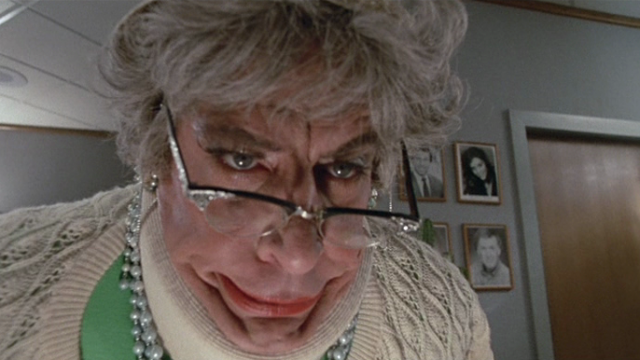The biggest benefit of watching kid’s movies is that they don’t really have to be coherent in the most traditional sense of the word. The biggest demand that children put on their media is that they have a consistent tonal quality. The popularity of Ernest Saves Christmas really pushes that trust to the extreme.
Ernest P. Worrell began as the marketing brainchild of John Cherry III and actor Jim Varney. Each commercial had the same format: Ernest would visit his “friend” Vern (never shown, the commercials were told in the first person from Vern’s point of view), and pester him with a ranting monologue while Vern constantly tried to get rid of him. The commercials, in a way, were meta commentary on the nature of commercials pretending to be your friend while pushing their product even as you were trying to get them out of the door. But, this ad took on a life of his own.
First, Varney and Cherry created the short film anthology, Hey Vern! It’s My Family Album, testing out a variety of wacky characters all played by Varney, and all related to Ernest. This was followed by the pair of movies Dr. Otto and the Riddle of the Gloom Beam, and Ernest Goes to Camp, which earned Varney a Razzie nomination for Worst New Star (he lost to then-16-year-old David Mendenhall in Over the Top). By 1988, we were reaching peak Ernest, when he had the television series Hey Vern! It’s Ernest and the movie Ernest Saves Christmas.
In a way, Ernest P. Worrell was a forerunner of the intentionally-oblivious under-intelligent salt of the earth comedic character. Ernest was a skinny roughly-shaven man who always wore a denim vest with a worn out baseball cap. In a way, his character feels like a minor satire of a factory worker, an image that would be taken up by Jeff Foxworthy and Larry the Cable Guy. He had a heart of gold, even as he wreaked havoc wherever he went.
When we first meet Ernest in Ernest Saves Christmas, he’s a cab driver ranting at his fare about life and the holidays. When his fare tells him to step on it, Ernest promptly tromps on the gas pedal, weaving in and out of traffic, to the point of ejecting his stunned fare out of the cab. What follows is a bizarre blend of endearing Santa mythology, chaos, teenage moralizing, zany characters, and a return to good old fashioned values. In Ernest Saves Christmas, Santa is only a temporary gig, who must be replaced every so often. Santa, flying down to Miami to pass off his power (as well as his bag, his reindeer and sleigh), finds things go awry when he leaves his bag in Ernest’s cab and his recruit takes a job in a holiday horror movie involving a swamp alien?
Perhaps the reason that Ernest Saves Christmas works as well as it does is that you’re never certain whether Santa’s story is merely to service Jim Varney and his variety of characters, or if Jim Varney is merely a strange actor placed into a high concept heartwarming Santa mythology. Director John Cherry certainly runs through a fair number of Ernest’s characters, his old mom, his business guy, his swamp dude, and we even have an extended Vern segment where Ernest delivers a Christmas tree, and proceeds to trash Vern’s house while the audience looks on helplessly. But, Santa’s tale is just as strange, sending him to jail, and having his flying reindeer escape their shipping crate at the airport to hang out on the ceiling.
Cherry only emphasizes the weirdness with his affinity for fish-eye lenses and Varney’s tendency to address the camera straight on. Varney is simply a warped element in a warped world. In its warped way, Ernest does restore traditional values of altruism and acceptance in a modern world warped by cynicism. Yet, the irony that we’re watching an ad is never far from sight. The movie opens with a series of classic Santa images, many of which have Santa drinking a Coca-Cola. When does advertisement become genuine? What’s the difference between kitsch and marketing? When does art and salesmanship merge? Ernest Saves Christmas has no answers for any of this, but it makes for a strange and nostalgic return to an era where things seemed hobbled together with spit and grit.


